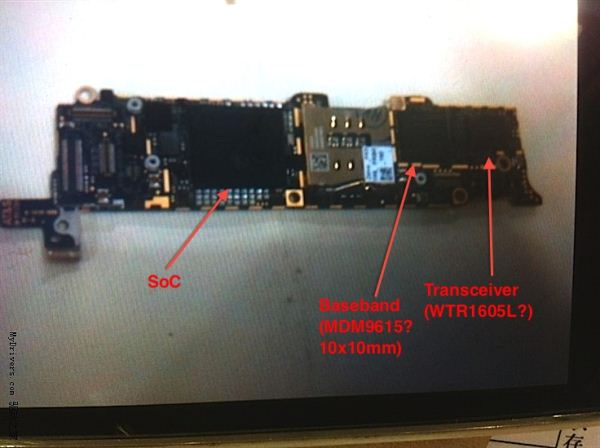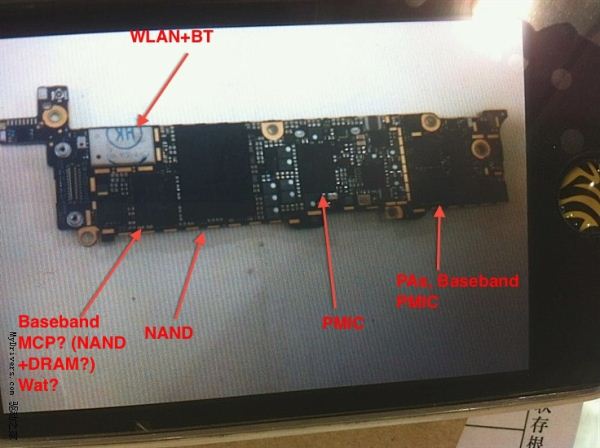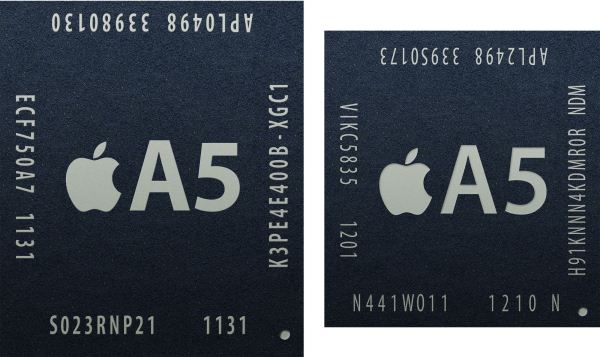Preparing for the iPhone Next: Rumors Analyzed
by Brian Klug & Anand Lal Shimpi on August 27, 2012 9:40 PM EST- Posted in
- Smartphones
- Apple
- Mobile
- iPhone
The SoC: 32nm A5R2?
So much of any new iPad/iPhone release is tied to the SoC. Apple remains one of the only handset designers that aggressively specs its own SoC rather than picking up an off the shelf part. As of late, Apple has used its control over its own SoC architecture to better match its chip architectures to the needs of its high resolution displays. Apple continues to produce its custom-designed SoCs at Samsung, although it's likely that Apple will consider other foundries at the 20nm node.


Rumored upcoming PCB, annotations ours
Most early looks at the next iPhone's internals show no silkscreened part numbers on the SoC. We've already seen blurry photos of the suspected upcoming PCB leak, though they're far too low quality to make out any chip markings. Given Apple's history, it's likely we'll see a 32nm LP (HK+MG) variant of the A5 SoC used in the iPhone 4S - perhaps at higher clocks. The move to a smaller process node should bring about a tangible increase in battery life. Depending on the workload, the iPhone 4S could burn more power than the iPhone 4 thanks to its beefy CPU + GPU combination. The move to 32nm could easily offset this penalty.
We've seen Apple experiment with Samsung's 32nm LP process in the past. Both the current generation Apple TV and the iPad 2,4 use a 32nm A5. In the case of the iPad 2,4, we saw a huge increase in battery life as a result of the move to 32nm. Some of the gains in battery life in the iPhone are likely to be offset by higher CPU/GPU clocks, but this is still the most likely approach for Apple this generation.

Original A5 (45nm, S5L8940, left), A5R2 (32nm, S5L8942, right)
As we mentioned back during our review of the iPad 2,4, it makes sense to test a new/unfamiliar process on a low volume part. By shipping 32nm A5 SoCs into some iPad 2s and the Apple TV (a hobby product), Apple could ride the 32nm yield curve up without adversely impacting shipments of its key money makers. With Samsung's 32nm LP process likely seeing much better yields now, it's time to deploy it in the next iPhone. Given much of the competition has moved to TSMC's 28nm process, Apple must remain competitive on the process node front as well. Shipping a 45nm SoC at the end of 2012 simply doesn't make sense. Although the current legal battles with Samsung could impact the relationship on the foundry side, simply switching to Global Foundries or TSMC is easier said than done. I would expect Apple to go through the same careful transition between Samsung and any other foundry as it did when it introduced the first 32nm A5s into the mix. The current expectations here are that we'll see Apple look at TSMC at the 20nm node.
With process node pretty much guaranteed, there's the question of CPU and GPU architectures.
Since the release of the original iPad, Apple has used the spring to introduce new SoC architectures in the iPad and later waterfall them down to the iPhone in the summer/fall. The A5X in the 3rd generation iPad however is still built on Samsung's 45nm LP process and is huge as a result of integrating four PowerVR SGX543 cores and implementing a 4 x 32-bit memory interface. The A5X needed the GPU power and memory bandwidth to drive the new iPad's retina display, but that power would be largely lost on the next iPhone.
The new iPhone is expected to have a 640 x 1136 resolution, thanks to its taller 4-inch display, but that's only 18% more pixels than the current iPhone 4S. A doubling of memory bandwidth and GPU compute horsepower would seem a bit excessive for current workloads. A ~20% increase in GPU clock speed, and faster DRAM would be enough to maintain current levels of performance on the higher resolution display.
Apple decoupled major cellular architecture and CPU architecture shifts in the past (e.g. iPhone 3G/3GS transition), which lends credibility to the idea of a move to A15 next year with the 4th gen iPad and sticking with the dual-core A9 design for the next iPhone. There's also the fact that TI is expected to be one of the first to bring an ARM Cortex A15 based SoC to market, and even it hasn't demonstrated an OMAP 5 running at shipping CPU clocks yet. I don't doubt that it's possible to ship an A15 based SoC before the end of the year, but based on the demos we've seen thus far, it seems highly unlikely to see one shipping in Q3. Apple doesn't like to be overly risky on the component front. There's nothing worse than a poorly yielding or otherwise problematic chip holding up shipments of one of your biggest revenue generators.










131 Comments
View All Comments
Super56K - Friday, August 31, 2012 - link
It's troubling that you pull the seniority card while sounding like a teenager with all the iSlander and hyperbole. I understand having dislike for company or brand X, but this is honestly the best way you have to voice that?Focher - Tuesday, August 28, 2012 - link
If you had any dedication to your principles, you would be wandering the streets and castigating people whom you see with Apple products. if you choose to do this, I suggest focusing on any nearby bus or subway so you don't stand out.versesuvius - Wednesday, August 29, 2012 - link
Not getting hit by an iSh.. will do just fine.Actually a good advice for iSh.. consumers, though.
cjs150 - Tuesday, August 28, 2012 - link
Beautiful design, great OS has everything a smart phone should have, and best battery life but...Why is it still rubbish at the basis function all phones should do - make and receive phone calls.
In my office we run a mixture of phones some old style bricks, iPhones and Samsungs Galaxy IIs.
The iPhone is by some distance the most flaky at phone calls, too many drop outs, voices fading out for no apparent reason. Even some friends who work very closely with Apple agree, if viewed purely as a phone with no "smarts", it is significantly weaker than 5 year old bricks from Nokia
iwod - Tuesday, August 28, 2012 - link
Sure that is not some thing to do with carrier rather then phone?cjs150 - Tuesday, August 28, 2012 - link
At work we are all on the same carrier.The iPhone is simply not good enough at phone calls. It is fine with a strong signal and you do not move around, but if walking and signal fades then iPhone will drop the call faster than any other phone we use, or just go silent
ajp_anton - Tuesday, August 28, 2012 - link
With a larger device allowing a physically larger battery, why does its capacity increase by such a meaningless amount?A5 - Tuesday, August 28, 2012 - link
I think it is thinner, so the overall volume isn't that different despite being larger in L and W.yankeeDDL - Tuesday, August 28, 2012 - link
I am not really sure what I expected, but is anyone else disappointed as I am?I am not an aApple user, and I will likely not become one after the iPhone5 is released, but I am interested in the trends, especially on the phones that are expected to set the standards.
The larger screen is a welcomed addition: for me 4" is the minimum in a smartphone, so I am glad that the iPhone caught up.
But no NFC? I am looking forward to NFC taking place and stop bringing my wallet around .. this won't hapen until all the mainstream phones will support it, so that's disappointing.
The phone also doesn't seem to have anything revolutionary ... which is probably the intention. Still, I was hoping to see the screen size take up nearly all the area of the phone, while it doesn't.
And what's with yet another proprietary connector? Why not USB + headphones, like every other normal phone?
I thought that the EU passed a regulation that every phone should have a standard charger. I guess I was wrong.
And what about making it easier to have an extra battery at the expense of slickness? My first mobile phone, 20 years ago, had 2 types of back cover: a thin/ligt and a thick/long-lasting. Can't compare really, but that phone lasted 2 weeks on a full charge with medium use (only a "phone" of course).
Mah!
MatthiasP - Tuesday, August 28, 2012 - link
For you 4" are the minimum, for me it's pretty much the maximum for a device i have to carry around. I'm glad there is atleast one highend phone that isn't so ridiculously big.